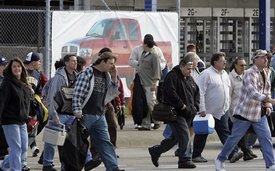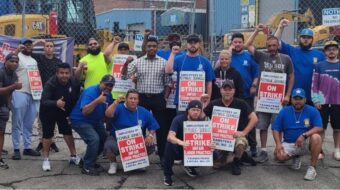
DETROIT — It was a little more than 30 years ago that General Motors had 395,000 United Auto Workers hourly employees. Two years from now, GM will have 38,000 union workers, a decline of over 90 percent.
How did this giant corporation, which once commanded 54 percent of the U.S. market (now under 20 percent), come to be in this situation?
* The company focused on building big gas-guzzling SUVs. While they were a source of big profits, they fell out of favor when gas prices went up.
* For several decades, GM and its fellow domestic auto companies have fought government regulations and fuel efficiency standards — even when those same kinds of regulations made them profitable in Europe and elsewhere.
* An emphasis on employer-based health care and pension plans, instead of fighting for universal plans that covered everyone, eventually caused the Big Three auto companies to be responsible for the benefits of hundreds of thousands of retirees and their dependents. The non-union “transplants” — foreign automakers like Toyota and Honda who have opened plants in the U.S. — with a much younger workforce and shorter history of operation do not have these costs.
* What once happened within the borders of the U.S., with GM either absorbing or out-competing and forcing the closure of other domestic auto manufacturers to become the country’s largest manufacturer, is now played out on a world scale. Worldwide there are multiple producers of autos for the U.S. and world market, and there has been a growth of non-union auto production in the South.
* Of course, the economic crisis has been the final nail in the coffin. But this is a worldwide contraction affecting auto producers throughout the world.
A deadly ripple effect
In announcing its Chapter 11 bankruptcy, GM said it would be closing 14 plants. Some 21,000 hourly workers will be losing their jobs. An estimated 2,100 dealerships will be closing. Seven of those shuttered plants will be here in Michigan.
Chrysler is closing eight plants —three in Detroit, and almost 900 dealerships.
The combined loss of dealerships will be approximately 3,000. With an average of 50 employees per dealership, total job loss from the dealer closings will be in the neighborhood of 150,000.
Parts suppliers will be closing and shedding employees, and white collar workers at GM and Chrysler are seeing huge job losses.
It has been said that every job at an auto assembly plant supports tens of others. That explains why Midwest states see their entire economy taking a hit.
For example, a steelworker from Pittsburgh said recently that 125,000 steel jobs have been lost in the recent period due to the crisis in auto, which is why steelworkers have been organizing rallies to protest the shutdown of auto plants. “When you don’t make cars, you don’t make steel” a steelworker told me at a recent rally.
Michigan — with seven times the auto jobs of the next highest state, Ohio — currently has a 12.9 percent unemployment rate.
Plant closures are taking place in cities like Pontiac, Flint, Ypsilanti and Grand Rapids in addition to Detroit.
The plants are often the largest or second largest taxpayer in town. For example in Pontiac, GM is the largest taxpayer and the city will lose one-fifth of its revenue for its general fund. A poor city already struggling with its finances will now see the ripple effect with more cutbacks in city services, public schools, fire, police and more.
Plunging pay, health care at risk
A question being asked is who is going to have the money to buy the new, green cars of the future? The 2007 contracts between the UAW and GM, Chrysler and Ford ushered in a two-tier wage system where new hires would be paid about one-half of the regular wage — $14 an hour instead of $28.
The bankruptcy of GM and Chrysler further deteriorated the bargaining power of autoworkers, and the new union concessions include: a no-strike pledge until 2015, work rule changes such as shorter break times and elimination of job classifications, and changes to how the union-administered Voluntary Employee Benefits Association (VEBA) that handles health care for retirees will be funded.
The VEBA was created in the 2007 contract and was to be mostly funded with cash from the company, $20 billion in the case of GM. Now it will mainly be funded with stock from the new, post-bankruptcy, reconstituted GM. The fund will have a 17.5 percent interest in GM. At Chrysler the fund will be similarly financed but will have a more than 50 percent stake in the new company.
At GM and Chrysler the UAW will appoint half of the VEBA board but an independent fiduciary, not the union, will run the fund for the benefit of the retirees. This is not union control of a company.
Back in 2007, many said the VEBA would be under-funded, considering how quickly health care costs skyrocket. Last week a commentator predicted, “Now it will fail in six years instead of 15.” Whatever the scenario, it is evident that the fight for national health care is today more critical than ever.
In exchange for its concessions the UAW was given assurances that GM will not propose terminating its pension plans. And the union was given assurances that a sub-compact originally scheduled for production in China would be made here at home.
The president’s auto task force also insisted that the new Fiat-Chrysler alliance build a new small car in a U.S. factory if they intend to sell the car in the United States.
Big political risk
Bankruptcy is a big political risk and gamble for the president and one which Republicans are waiting to pounce on.
However if Sen. McCain had won the election, there would have been no government loans, and a chapter 7 bankruptcy — a complete liquidation of GM and Chrysler — would likely have taken place. The companies would have been ripped apart, sold piecemeal, with even more job losses. Health care and pension assurances would have been non-existent.
And while you do hear acknowledgement here that the president has intervened to keep this industry going, those losing their jobs are not going to enjoy the benefits and if in the end bankruptcy does not result in a viable company, there is danger that anger will be directed at the president. Some already is.
There is also anger that money is going to GM but plants are closing here while production increases are planned for GM plants in Mexico, Korea, China and elsewhere. The UAW did press for GM to agree to build a sub-compact in the U.S. and received a commitment that may keep one plant running.
The Obama administration, wrongly I believe, is taking the view that it will not get involved in the day-to-day management and so far has not demanded that the taxpayer money received by GM be used for keeping production here (an exception being the sub-compact).
Yes, it is good the administration’s auto task force is meeting with communities that are facing job losses to assess their needs, but more — much more — needs to be done.
New thinking needed
A fundamental problem is that plants are being closed without a well-thought-out alternative plan to retool for other production, whether that is mass transit, high-speed rail cars, green products such as wind turbines and solar panels, or any number of products needed to rebuild our infrastructure.
It is an old way of thinking that has a plan for saving the corporation but not the workers and not the needs of the country as a whole, a country that needs a manufacturing base.
While the government now has a majority stake in GM, this is not socialism as the right maintains.
The “Save Jobs, Reinvest in America” rallies that have been taking place across the Midwest are being organized by the Steelworkers union. The UAW, for whatever reason, has not endorsed them. Many feel that a strong push by the UAW, that unites all of labor and the community, is needed to rally the forces necessary to keep manufacturing in Michigan and in the U.S.
Two reactions to the crisis that are gaining ground will not fundamentally alter the outcome and may prolong it. One is “Buy American” and the other is a focus on erecting trade barriers.
Both approaches take the heat off the companies for exporting jobs and lowering working standards throughout the world. GM has operations in some 30 countries as it seeks to pay the lowest wages possible, avoid union representation and pit workers in one country against those in another.
The popular Ford Fusion is made in Mexico and is just one example of American nameplates that are not “made in America.”
It is right to demand that most taxpayer money given to the companies should be used for production here, and we do need to rid ourselves of trade pacts like NAFTA that have made it easier for capital to exit the country. But it is important to remember that the loyalty of the auto companies is to profits, not to the workers.
The impact of the auto crisis in the main urban areas of Michigan and the Midwest falls heavily on African American, Latino and all racially oppressed.
The unemployment rate in these areas is 30 percent and higher. mmediate help is needed.
While Federal Reserve Chair Ben Bernanke worries about the future effect of an increasing deficit, the real worry is who is going to feed, clothe, house, educate, train and give medical care to the millions who have no future?
And this danger far outweighs Bernanke’s concerns. We are most likely facing a prolonged downturn. In the past, manufacturing helped the country come out of a recession (every job in auto driving 10 others shows why). It will not be able to have that same effect for this downturn.
As good as President Obama’s first stimulus was, we need a second stimulus to insure that those in our urban core, and other communities devastated by this crisis, have a future at all.
jrummel @ pww.org









